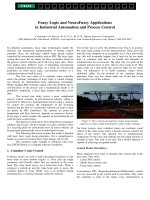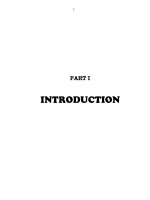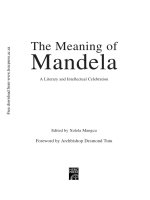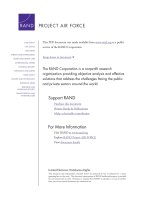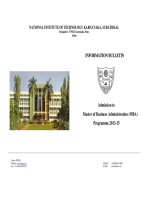algebraic aproach to meaning of linguistic terms, fuzzy logic and approximate reasoning
Bạn đang xem bản rút gọn của tài liệu. Xem và tải ngay bản đầy đủ của tài liệu tại đây (4.76 MB, 93 trang )
ALGEBRAIC APROACH TO MEANING OF
ALGEBRAIC APROACH TO MEANING OF
LINGUISTIC TERMS, FUZZY LOGIC AND
LINGUISTIC TERMS, FUZZY LOGIC AND
APPROXIMATE REASONING
APPROXIMATE REASONING
Nguyen Cat Ho
Nguyen Cat Ho
Institute of Information Technology
Institute of Information Technology
(VAST)
(VAST)
E-mail:
E-mail:
July 1, 2014 2
I. Introduction
I. Introduction
Well know that: Languages are human tools to cognize the
reality
→ They sufficient to model facts, processes in reality in their
own way.
However, up to now one has still not discovered the
mathematical structure of term-domains of linguistic variables,
as Rinks wrote in “A heuristic approach to aggregate
production scheduling using linguistic variables, Proc. of Inter.
Congr. on Appl. Systems Research and Cybernetics, Vol. VI
(1981)” that
"verbal coding is a human way of repackaging material into a
few chunks of rich information. Natural language is rather
unique in this characteristic. Until recently, a unified theory for
manipulating in a strict mathematical sense non-numerical-
valued variables, such as linguistic terms, did not exist."
A question is how can we find out a mathematical structure
to model the meaning of linguistic terms ?
July 1, 2014 3
I. Introduction
I. Introduction
1965 L.A. Zadeh, in his paper
“Fuzzy sets, Information and Control 8 (1965)”,
Fuzzy sets were introduced to model the meaning
of linguistic terms of natural languages.
In natural language there are vague terms such as
young, old, rather large, approximately 9, …
1
0.5
25 35 U
July 1, 2014 4
I. Introduction
I. Introduction
1965 L.A. Zadeh, in his paper
“Fuzzy sets, Information and Control 8 (1965)”,
Fuzzy sets were introduced to model the meaning of
linguistic terms of natural languages.
- Allow manipulate and process fuzzy, uncertain and
inexact information;
- Establish a computation approach (analytic one) to
simulate human reasoning methods, based on fuzzy sets
and fuzzy logics;
- Open a new era of developing applications in uncertain
environment of industry, sciences, social-economy, …
- Now, we can find everywhere applications of fuzzy sets
like in cars, washing machines, air conditioners, ….
The achievements of fuzzy sets theory are very great and
incontrovertible. However, it inherits still some problems.
July 1, 2014 5
I. Introduction
I. Introduction
Some problems:
Representation of linguistic terms by fuzzy sets means
that one should establish an embedding:
ϕ
: Dom(X)
→
F(U,[0,1]). Since the image of Dom(X) under
ϕ
has no
mathematical structure, operations on fuzzy sets are
defined on the whole space F(U,[0,1]). It seems to be
unreasonable and, moreover, not correct, because
- Dom(X) is finite, but F(U,[0,1]) is infinite;
- We observe that Dom(X) has a semantics-based
ordering relation
≤
, but
ϕ
does not preserve this relation.
+ Maybe, by these reasons the efficiency of fuzzy sets-
based methods is limited.
+ Moreover, these methods are complicated, in general.
July 1, 2014 6
1 Introduction
1 Introduction
Term-domain Dom(X) as a rich enough
algebra:
The question is that can we discover an algebraic
structure of Dom(X) sufficient for studying fuzzy logic and
approximate reasoning methods.
+ The answer is affirmative
+ Since late 1980s: an algebraic approach to the structure
of term-domains of linguistic variables has been introduced:
- Dom(X) = AX = (X,C,H,
≤
);
- A wide class of HAs: Lattices;
- Symmetrical HAs: algebraic foundation of non-classical
logics;
July 1, 2014 7
1 Introduction
1 Introduction
Application of HAs:
+ Linguistic reasoning: Inference rules allow
handle linguistic
terms directly;
+ Relational Databases with Linguistic data:
Unified way for
manipulating data types;
+ New approximate reasoning method:
Interpolative reasoning based on SQMs
+ Application in Fuzzy Control: the results are
much better.
July 1, 2014 8
1 Introduction
1 Introduction
We shall talk about
An overview of fuzzy sets theory and its
computation mechanism
Hedge algebras – a semantics- based structure of
terms-domains
Quantification method of hedge algebras: Fuzziness
Measure of linguistic terms, hedges and
Semantically Quantifying Mappings
Applicability of hedge algebras
Some Conclusions
July 1, 2014 9
2 Fuzy Sets: An Overview
2 Fuzy Sets: An Overview
Definition of Fuzzy Sets and Their Operations
Example: Representation of the meaning of young
1
0.5
25 35 U
+ Definition: Fuzzy set is an (ordinary) set A of pairs
{(u,
µ
A
(u)) : u
∈
U,
µ
A
(u)
∈
[0,1]}.
µ
A
(u) is membership degree of u and
µ
A
is a membp
function.
Denote the set of all fuzzy sets on U by F(U,[0,1]).
July 1, 2014 10
2 Fuzy Sets: An Overview
2 Fuzy Sets: An Overview
+ Fuzzy Sets Operations
Given fuzzy sets A and B
Union: A
∪
B
µ
A
∪
B
(u) =
µ
A
(u)
∨
µ
A
(u) 1
Intersection: A
∩
B 0.5
µ
A
∩
B
(u) =
µ
A
(u)
∧
µ
A
(u)
25 35 U
Complement: CA
µ
CA
(u) = 1 -
µ
A
(u).
µ
A
(u) is membership degree of u and
µ
A
is a membp
function.
Denote the set of all fuzzy sets on U by F(U,[0,1]).
July 1, 2014 11
2 Fuzy Sets: An Overview
2 Fuzy Sets: An Overview
Cartesian Product: A
×
B
µ
A
×
B
(u) =
µ
A
(u)
∧
µ
A
(u)
+ Fuzzy Sets representing logical connectives
Given fuzzy sets A and B
- AND, OR, NEGATION by Union, Intersection and Complement
- If X is A then Y is B : A
⇒
B
µ
A
⇒
B
(u,v) =
µ
A
(u)
→
*
µ
A
(v) , where
→
* is a logical implication
R
B/A
denotes fuzzy relation with
µ
R
B/A
(u,v) =
µ
A
⇒
B
(u,v).
+ Approximate Reasoning
July 1, 2014 12
2 Fuzy Sets: An Overview
2 Fuzy Sets: An Overview
+ Approximate Reasoning
E.g. in fuzzy control one can model a dependency between
physical variables X
j
and Y linguistically:
If X
1
= A
11
and and X
m
= A
1m
then Y = B
1
. . . . . . . . . . . . . . . .
If X
1
= A
n1
and and X
m
= A
nm
then Y = B
n
It is called a fuzzy model representing expert knowledge.
Approximate reasoning problem: FMCR problem.
A method which solves this problem is called FMCR
method.
July 1, 2014 13
2 Fuzy Sets: An Overview
2 Fuzy Sets: An Overview
+ Main Steps of FMCR methods:
1) To construct appropriate fuzzy sets (membership problem)
2) To define a fuzzy relation R
i
= R
Bi/Ai
on U
1
×
×
U
n
×
V to
represent the semantics of if-then sentence in the given
fuzzy model, by choosing suitable implication operator.
3) To define a fuzzy relation R on U
1
×
×
U
n
×
V to represent the
semantics of the fuzzy model by choosing an aggregation
operator for aggregating fuzzy relations R
i
defined above:
R = Union {R
1
, … , R
n
} or R = Intersection {R
1
, … ,
R
n
}
4) Problem of determining an appropriate composition
operator to compute the output fuzzy set.
5) To define a suitable defuzzification method to transform an
output fuzzy set into a real value.
July 1, 2014 14
2 Fuzy Sets: An Overview
2 Fuzy Sets: An Overview
+ Example: Aircraft Landing Problem (Ross T. J.,
Fuzzy logic with engineering application,
International Edition. Mc Graw-Hill, Inc, 1997)
v
h
Aim: Landing gently to avoid
Aim: Landing gently to avoid
h : High v : Vertical velocity
If a force f applied over a time ∆t a
change in v will be ∆v = f∆t/m.
Choose ∆t = 1.0 (sec) and m = 1.0
(lb-sec
2
/ft), we have ∆v = f. Using different notation, we have:
v
i+1
= v
i
+ f
i
and h
i+1
= h
i
+ v
i
(for cycle calculating).
July 1, 2014 15
2 Fuzy Sets: An Overview
2 Fuzy Sets: An Overview
Fuzzy control method:
State variables
v
i+1
= v
i
+ f
i
and h
i+1
= h
i
+ v
i
1) Define a set of fuzzy
rules (FAM):
2) membership functions
for state variables h
v
v
h
h
DL
DL
DS
DS
Z
Z
US
US
UL
UL
L
L
Z
Z
DS
DS
DL
DL
DL
DL
DL
DL
M
M
US
US
Z
Z
DS
DS
DL
DL
DL
DL
S
S
UL
UL
US
US
Z
Z
DS
DS
DL
DL
NZ
NZ
UL
UL
UL
UL
Z
Z
DS
DS
DS
DS
1.0
0.4
300
0 500 800 1000
NZ
S M
L
July 1, 2014 16
2 Fuzy Sets: An Overview
2 Fuzy Sets: An Overview
Fuzzy control method:
State variables
v
i+1
= v
i
+ f
i
and h
i+1
= h
i
+ v
i
1) Define a set of fuzzy
rules (FAM):
2) membership functions
for state variables v = u
v
v
h
h
DL
DL
DS
DS
Z
Z
US
US
UL
UL
L
L
Z
Z
DS
DS
DL
DL
DL
DL
DL
DL
M
M
US
US
Z
Z
DS
DS
DL
DL
DL
DL
S
S
UL
UL
US
US
Z
Z
DS
DS
DL
DL
NZ
NZ
UL
UL
UL
UL
Z
Z
DS
DS
DS
DS
1.0
0.4
- 10
- 30
0
20 30
DL
Z
US
ULDS
- 20
10
July 1, 2014 17
Fuzzy control method: remember that
∆
v = f therefore:
v
i+1
= v
i
+ f
i
and h
i+1
= h
i
+ v
i
(*)
3) Define initial conditions and conduct a simulation for k
cycles:
+ h
0
= 1000 ft ; v
0
= - 20 ft/s. f
0
to be computed ; High h
fires L at 1.0 and M at 0.6; Velocity v fires only DL at 1.0.
Compute f
0
: L (1.0) AND DL (1.0)
⇒
Z (1.0)
M (0.6) AND DL (1.0)
⇒
US (0.6)
f
0
= Centroid of the yellow figure = 5.8
Using (*), have h
1
= 980, v
1
= - 14.2 ft/s
1.0
0.4
- 10
- 30
0
20 30
DL
Z
US
ULDS
- 20
10
0.6
July 1, 2014 18
Fuzzy control method:
v
i+1
= v
i
+ f
i
and h
i+1
= h
i
+ v
i
3) Define initial conditions and conduct a simulation for k cycles:
+ Now, inputs for Cycle 1: h
1
= 980, v
1
= - 14.2 ft/s
High h fires L at 0.96 and M at 0.64; Velocity v fires only DS at
0.58 and DL at 0.42.
L (.96) AND DS (.58)
⇒
DS (.58); L (.96) AND DL (.42)
⇒
Z
(.42)
M (.64) AND DS (.58)
⇒
Z (.58) ; M (.64) AND DL (.42)
⇒
US
(.42)
Compute f
0
= Centroid of the union of outputs = - 0.5 lbs
1.0
0.4
300
0 500 800 1000
NZ
S M
L
980
0.96
0.64
July 1, 2014 19
II. Algebraic approach:
II. Algebraic approach:
Hedge algebras - Models of
Hedge algebras - Models of
terms- domains based on linguistic meaning
terms- domains based on linguistic meaning
Why we can and need introduce algebraic approach ?
Consider a set of terms of the TRUTH variable:
Consider a set of terms of the TRUTH variable:
True, V true, M True, A True, P True, VA True, MA True, VP True,
True, V true, M True, A True, P True, VA True, MA True, VP True,
MP True, VV true, VM True
MP True, VV true, VM True
False, V False, M False, A False, P False, VA False,
MA False, VP False, MP False, VV False, VM False
It can be seen that:
True ≤ V True, M True ≤ V True, …
A True and P True are incomparable !!
X
- a linguistic; X = Dom(
X
)- a set of terms
X
X
:= (
:= (
X
X
,
,
H
H
,
,
C
C
,
,
≤
≤
)
)
is at least a Poset (Partially Ordered Set)
is at least a Poset (Partially Ordered Set)
July 1, 2014 20
II. Hedge algebras - algebraic models of
II. Hedge algebras - algebraic models of
linguistic domains based on ling. meaning
linguistic domains based on ling. meaning
An algebraic structure of
X
: AX = (Dom(
X
),C,LH,
≤
)
X =
X =
Dom(
Dom(
X
X
)
)
can be ordered based on meaning of terms:
can be ordered based on meaning of terms:
–
X owns an ordering relation
X owns an ordering relation
≤
≤
, induced by term meaning and
, induced by term meaning and
called
called
semantically ordering relation
semantically ordering relation
;
;
–
Several semantic properties of terms and hedges can be
Several semantic properties of terms and hedges can be
formulated in term of
formulated in term of
≤
≤
:
:
Positiveness and negativeness base term:
Positiveness and negativeness base term:
c
c
–
–
≤
≤
c
c
+
+
Positive hedges:
Positive hedges:
c
c
+
+
≤
≤
hc
hc
+
+
and
and
c
c
–
–
≥
≥
hc
hc
–
–
.
.
The set
The set
H
H
+
+
Negative hedges:
Negative hedges:
c
c
+
+
≥
≥
hc
hc
+
+
and
and
c
c
–
–
≤
≤
hc
hc
–
–
.
.
The set
The set
H
H
–
–
For ex.
For ex.
old
old
<
<
Very old
Very old
,
,
young > Very young
young > Very young
while
while
old
old
>
>
Possibly old
Possibly old
,
,
young < Little young
young < Little young
July 1, 2014 21
II. Hedge algebras - algebraic models of
II. Hedge algebras - algebraic models of
linguistic domains based on ling. meaning
linguistic domains based on ling. meaning
Positive hedges:
Positive hedges:
c
c
+
+
≤
≤
hc
hc
+
+
and
and
c
c
–
–
≥
≥
hc
hc
–
–
.
.
The set
The set
H
H
+
+
Negative hedges: c
+
≥
hc
+
and c
–
≤
hc
–
. The
set H
–
+
+
For ex.
For ex.
old
old
<
<
Very old
Very old
,
,
young > Very young
young > Very young
⇒
⇒
V
V
∈
∈
H
H
+
+
old
old
<
<
More old
More old
,
,
young > More young
young > More young
⇒
⇒
M
M
∈
∈
H
H
+
+
while
while
old
old
>
>
Possibly old
Possibly old
,
,
young < Possibly young
young < Possibly young
⇒
⇒
P
P
∈
∈
H
H
–
–
old
old
>
>
Little old
Little old
,
,
young < Little young
young < Little young
⇒
⇒
L
L
∈
∈
H
H
–
–
On each
On each
H
H
ε
ε
we can define an ordering relation :
we can define an ordering relation :
h
h
≤ k
≤ k
iff
iff
x ≤ hx
x ≤ hx
implies that
implies that
hx ≤ kx
hx ≤ kx
and
and
x
x
≥
≥
hx
hx
implies that
implies that
hx
hx
≥
≥
kx
kx
July 1, 2014 22
II. Hedge algebras
II. Hedge algebras
Positiveness of h w.r.t. k :
x
≤
kx
≤
hkx or x
≥
kx
≥
hkx
Negativeness:
x
≤
hkx
≤
kx or x
≥
hkx
≥
kx
For ex.: true
≤
M true
≤
VM true
true
≥
VP true
≥
P true
true
≥
L true
≥
VL false
false
≤
VA false
≤
A false
V, M are positive w.r.t. V, M, L negative w.r.t. A,
P, ML.
V
V
M
M
A
A
P
P
L
L
V
V
+
+
+
+
-
-
-
-
+
+
M
M
+
+
+
+
-
-
-
-
+
+
A
A
-
-
-
-
+
+
+
+
-
-
P
P
-
-
-
-
+
+
+
+
-
-
L
L
-
-
-
-
+
+
+
+
-
-
July 1, 2014 23
II. Hedge algebras
II. Hedge algebras
The algebraic sign of a term:
Based on these notions, we can define
a notion of algebraic sign of terms.
Definition (Sign function).
Sign: X
→
{
1,0,1} is defined
recursively as follows:
a) Sign(c
) =
1, Sign(c
+
) = +1;
b) Sign(khx) =
Sign(hx), if khx
≠
hx
and k is negative w.r.t. h;
and Sign(khx) = 0 if khx = hx
c) Sign(khx) = +Sign(hx), if khx
≠
hx
and k is positive w.r.t. h;
Ex.: VPA true (- + - + = +) ; LPAV false (+
+ - + - = +) (!)
V
V
M
M
A
A
P
P
L
L
V
V
+
+
+
+
-
-
-
-
+
+
M
M
+
+
+
+
-
-
-
-
+
+
A
A
-
-
-
-
+
+
+
+
-
-
P
P
-
-
-
-
+
+
+
+
-
-
L
L
-
-
-
-
+
+
+
+
-
-
July 1, 2014 24
II. Hedge algebras
II. Hedge algebras
Semantic inheritance of hedges: Because each
hedge h modifies only the meaning of term, it
preserves essential meaning of terms and we can
formulate this property in term of
≤
:
For ex. L true
≤
A true
⇒
true
≤
L true
≤
PL true
≤
LA true
≤
A true
Formulation of the property:
hx
≤
kx
⇒
h’hx
≤
k’kx so H(hx)
≤
H(kx)
This means that h’ and k’ can not change the
meaning of hx and kx represented by hx
≤
kx. (!)
July 1, 2014 25
•
Semantic inheritance of hedges:
hx
≤
kx
⇒
H(hx)
≤
H(kx)
+ Granular information
+ Fuzziness notion
+ Fuzziness measure
H(true)
H(M true)
H(V true)
H(A true)
H(P true)
H(L true)
H(ML true)
H(M L A true)
H(LLA true)
H(A L true)
H(P L A true)
H(V L A true)
H(ML L A true)
H(LA true)
Basic structure
(!)

